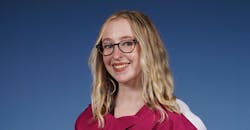Faces in Photonics: Hollie Wright, Heriot-Watt University
The Faces in Photonics series shines a light on scientists, researchers, and educators from all over the world whose work is reshaping the optics and photonics industry. This month we are spotlighting Hollie Wright, a research associate at Heriot-Watt University in Scotland.
LFW: Why did you choose a career in photonics?
HW: I studied physics at the University of St. Andrews in Scotland for my undergrad. The department does high-quality research in photonics, so studying there introduced me to the field and gave me an opportunity to learn from high-profile researchers.
As I prepared to finish my undergrad degree, I started looking for jobs in industry. I hadn’t considered doing a Ph.D. I assumed early on it wasn’t for me, but I was introduced to the Centre for Doctoral Training in Applied Photonics [https://cdtphotonics.hw.ac.uk], which runs a Ph.D./EngD training program where graduate students are partnered with an industry sponsor.
This training allowed me to do Ph.D.-level research while also getting involved in industry. It’s exciting to be working at the intersection of university research and industrial innovation. I’m grateful to have been given the opportunity and to have had very supportive supervisors: Professor Derryck Reid and Professor Nick Weston.
LFW: What did your EngD work involve?
HW: I developed a variation on dual-comb metrology that is suitable for industrial applications. Dual-comb metrology is a powerful, high-precision measurement technique, but when I began my research it was quite complex and hadn’t yet made the transition to an industrial technique.
So I developed a variation on the technique, two-photon dual-comb LiDAR, which significantly simplifies it without any loss of performance. This improvement will help the technique finally make the transition to an industrial tool.
LFW: What are you working on now?
HW: I’m continuing my research on two-photon dual-comb LiDAR and currently investigating new capabilities of the technique, such as in making multiple measurements simultaneously. I’d like to eventually use the technique for real-time tracking of the movement of manufacturing machines to enable in-process verification during manufacturing.
Currently, quality control in the manufacturing sector involves verification processes that take place at the end of production—and it’s inefficient and costly. Incorporating my technique into manufacturing processes would allow verification in real time, which would allow the manufacturing sector to become more efficient and sustainable.
LFW: How do you see LiDAR evolving?
HW: At the moment, LiDAR is predominantly used as a standalone tool for measuring distances. In the future I think we’ll see LiDAR technology be incorporated into other technologies. We’re already seeing this in self-driving cars, so I’m excited to see where else this technology can be applied.
Personally, I’d like to see LiDAR used to control machinery and robotics. This would be very advantageous because it could allow motion control with greater accuracy than the internal controls can provide. But a big challenge to achieving this is to create a system that can interpret LiDAR information and make subsequent real-time decisions.
LFW: Biggest challenges for early career women in photonics?
HW: During the past decade or two, we’ve seen many initiatives to improve diversity within the field. Unfortunately, it tends to fall on women to continue these initiatives, which results in a challenge for women within the field now who want to ‘send the elevator back down’ for the next generation of women but also don’t want their impact to be limited to diversity work.
LFW: What do you love most about your work?
HW: My favorite thing is how varied it is. Things are always changing and we’re constantly facing new challenges. I’m grateful to have work so engaging and fulfilling.
About the Author
Sally Cole Johnson
Editor in Chief
Sally Cole Johnson, Laser Focus World’s editor in chief, is a science and technology journalist who specializes in physics and semiconductors.

